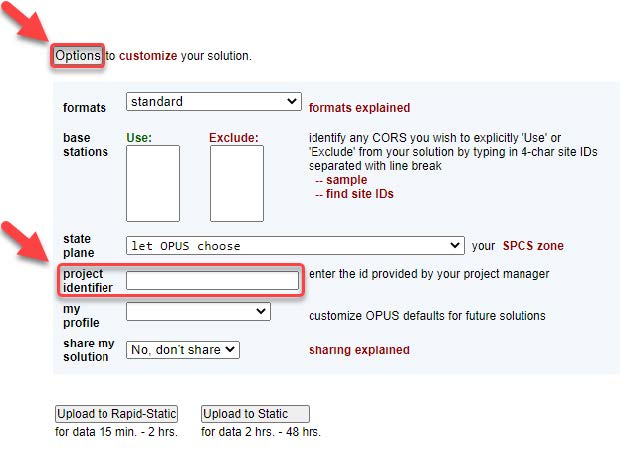6.1. How to Load GNSS Observations into OPUS
OPUS should be capable of ingesting the most common vendor-specific GNSS file formats. If the file format is not recognized, OPUS will show a file upload error. In that case, refer to your vendor for tools to convert your proprietary file format to the Receiver Independent EXchange format (RINEX).
The information required for successful uploading to your project includes:
GNSS observation file name (either RINEX file or other file format supported by OPUS: see here for more information on data files supported)
Antenna type and model (to apply the correct antenna phase center offset; see NGS Antenna Calibration for more information)
Antenna height (meters) -this is the vertical distance from the vertical point of reference of the usermark to the GNSS Antenna Reference Point (ARP).
Email address
Caution
OP will retain antenna heights to the fourth decimal place (0.0001 m) in its computations, but will only display antenna heights rounded to the nearest millimeter in output files and tables (0.001 m)
If the project will include GVX files, the user must also obtain the static GNSS observation files (RINEX files) for each base station for all vectors provided in the GVX file(s) and upload them to OP. Download a minimum of three full day (24-hour) data files at each base station and ensure that the data also overlap in time with the days of your RTN measurements. Note, it is not necessary to download and upload base station data files that are part of the NOAA CORS Network.
Tip
If your project contains GVX files you should download, from your RTN provider, the static GNSS data files (RINEX files) logged at each base station that was used during your RTK/RTN survey. Download a minimum of three full day (24-hour) data files at each base station and ensure that the data also overlap in time with the days of your RTN measurements.
Caution
If the base station used during your RTK/RTN survey is part of the NOAA CORS Network, you do not need to upload the base stations RINEX file.
To add the observation to your project, the user must click on the “Options” button (shown in Fig. 6.1) and submit the project identifier that was assigned to the project upon its creation, as shown in Fig. 6.2.

Fig. 6.1 OPUS processing customization options

Fig. 6.2 Project Identifier Option
Caution
If the user’s profile is used, be careful that the correct antenna model and antenna height are selected. Using the profile can be a powerful tool, but it can also lead to unintended consequences if the user is not careful.
Tip
Delete My Profile before each new project is populated with observation data to make sure unintended errors are not introduced when data are uploaded into a new project
ZIPPING FILES: If all of your antennas are the same type and model (i.e. they all have the exact same antenna center offset per the antenna calibration) and were all set at the same height, you can bulk upload the observation files after first zipping them into one *.zip file, and pointing to the zipped file at the time of upload.